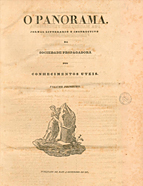

................................
In these first two series of O Panorama, we also see the development of trends that would become a hallmark of the literary market, giving rise to the newspaper’s literary identity, as indicated by its subtitle. These included the historical novel and critique. The historical novel, based on real events or figures, became an important tool for publicising history. Apart from its entertainment value, it played a pivotal role in spreading historical knowledge. As Herculano remarked, "We seek to save national poetry of our greatest figures from oblivion" ( O Panorama , note, Issue 126, p. 306, 1839). However, he was careful not to conflate history with fiction. He introduced a hybrid model: "In this, we presented the chronicle; in the clothes with which we adorned it, we presented the novel." There were numerous examples of pamphlet-novels published in O Panorama , a genre sometimes criticised by the intellectual elite, which called for higher-quality works. Alexandre Herculano made significant contributions, such as Arras por foro de Espanha [Dowry by Spanish Law], first published in Issue 236, p. 356, 1841, and later included in Lendas e Narrativas [Legends and Narratives] in 1851. The inclusion of short novels, excerpts from longer works, and parts of plays was a strategic move by the newspaper’s directors to captivate the audience and test whether these works might warrant future publication as books ( A elite intelectual e a difusão do livro nos meados do século XIX [The intellectual elite and the dissemination of books in the mid-19th century], p. 544).
The critique section served a similar function, acting as a mediator in the book market. Newspapers, in general, were key for such critical assessments. O Panorama frequently reviewed various works, including novels and historiographies, and contributed significantly to literary critique (see S.C. Matos, Historiografia e Memória Nacional no Portugal do século XIX [Historiography and National Memory in 19th Century Portugal], pp. 147-150). An example of this is Herculano’s critique of Castilho’s Quadros históricos de Portugal [Historical pictures of Portugal] (1838) ( O Panorama , Issue 68, 1838, p. 263). The critique extended beyond books to include reviews of other periodicals, such as the Revista Universal Lisbonense , which was regarded as a complement to O Panorama ( O Panorama , Issue 23, p. 184, 1842).
This work is financed by national funds through FCT - Foundation for Science and Technology, I.P, in the scope of the projects UIDB/04311/2020 and UIDP/04311/2020.
